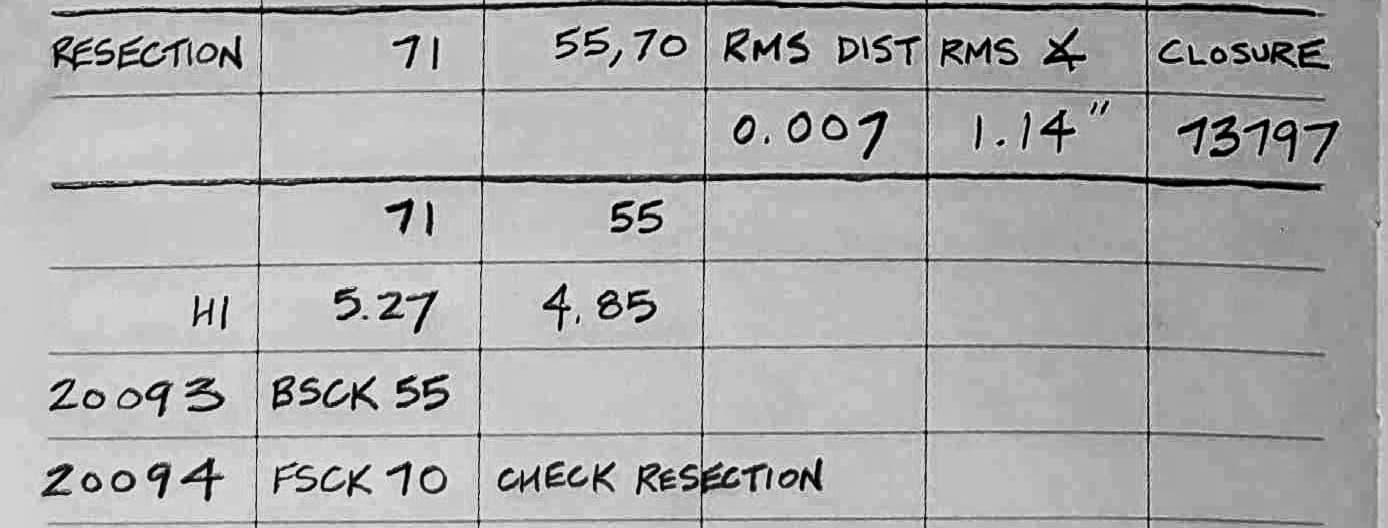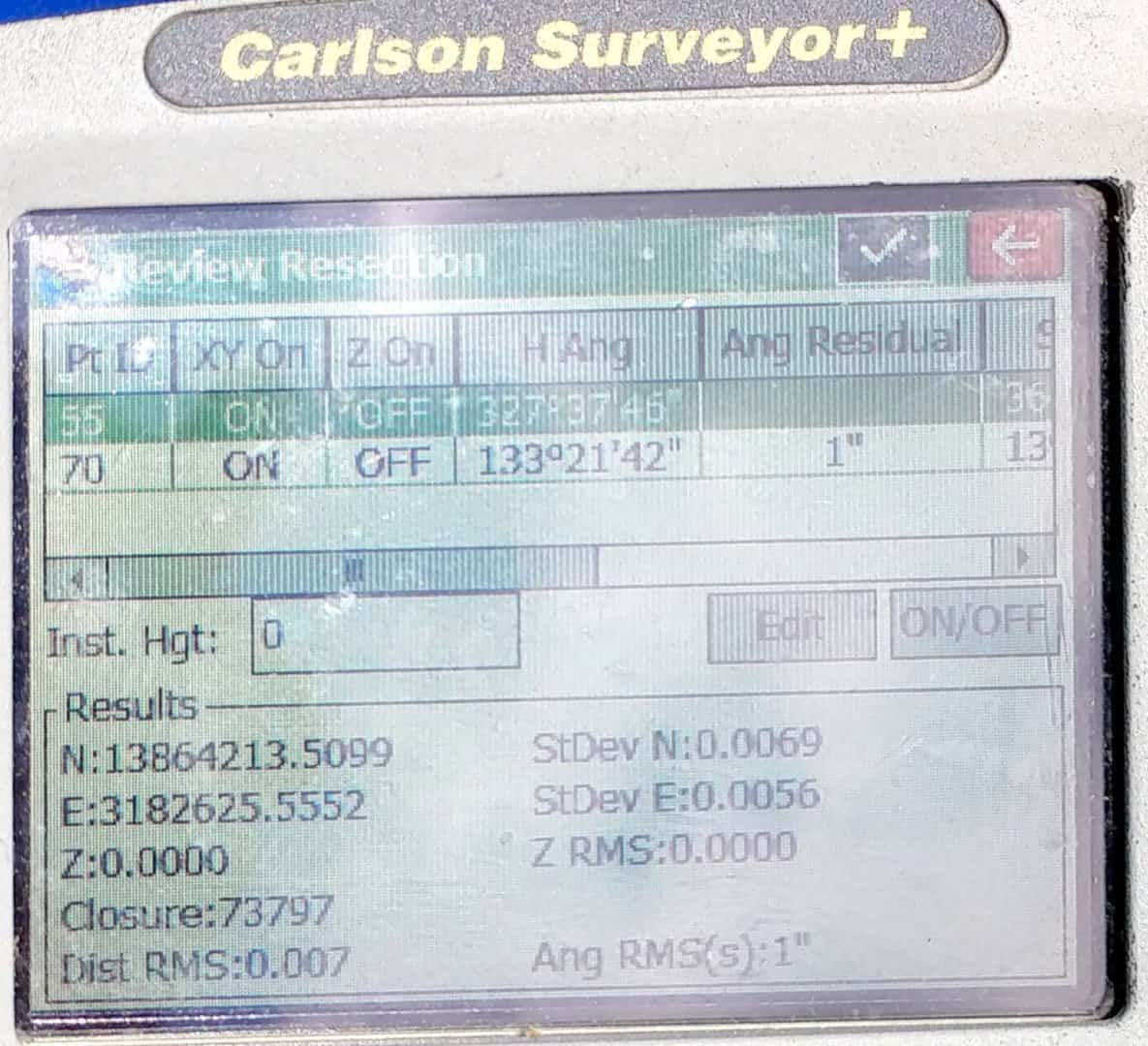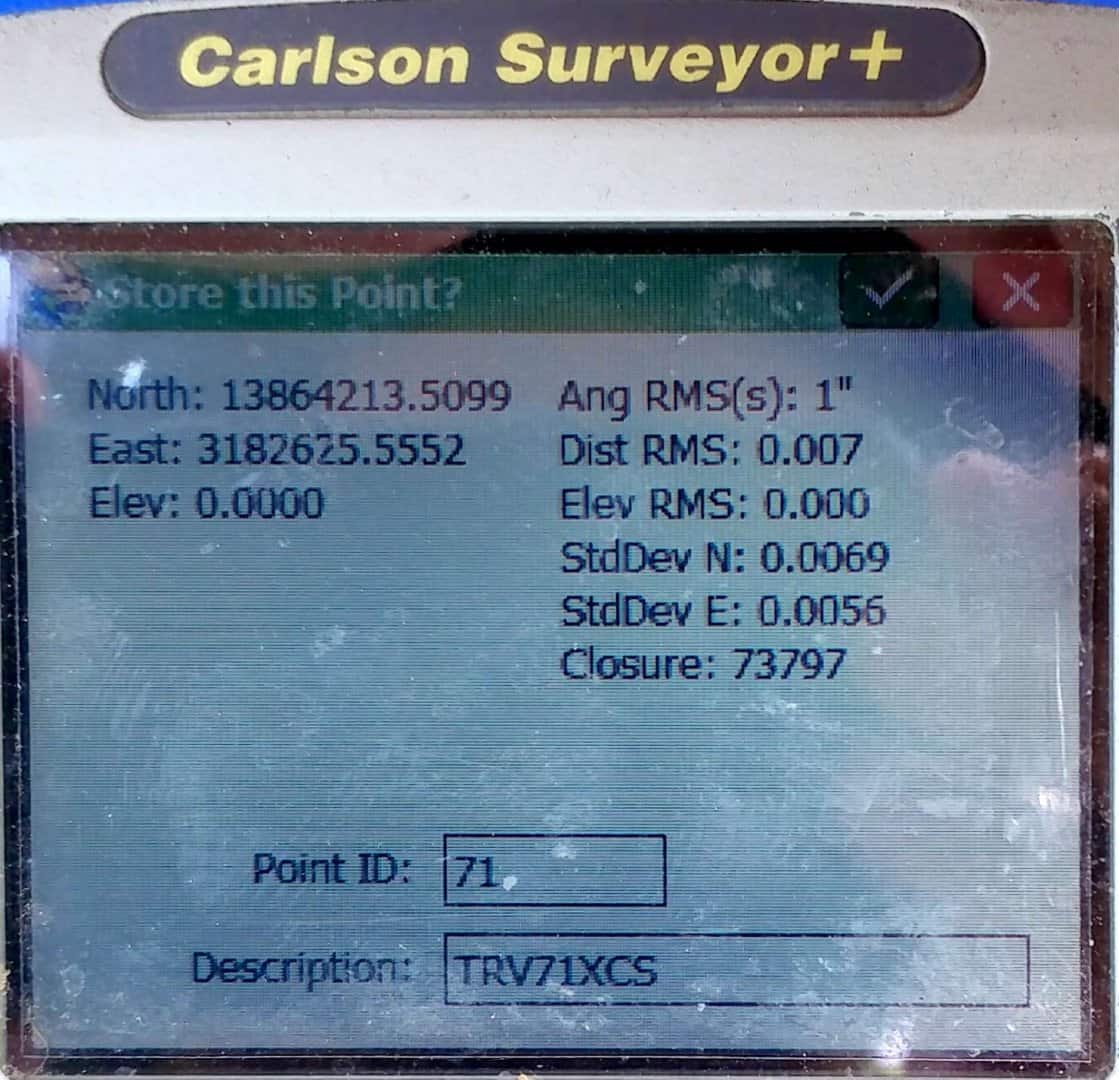Can anyone explain what the Closure Value for a Resection indicates?
I know what to watch out for in terms of bad geometry and RMS values. I've also found literature on a few methods for computing a Resection by hand, and I can follow the math for the most part. I'm not sure what Carlson is showing me with the Closure Value though.
I attached two photos of a Resection I did today. Any help will be appreciated.
I would guess that the Closure is 1 in 73797. The angular closure (Root Mean Square) is within 1" and the distance within 0.007.
Would you say that that was satisfactory?!
My version of Carlson uses the first point shot as the basis of control to the existing coordinates and rotates to the second point shot.
The closure is like that of a closed traverse.
1 in 73,797 is excellent
Your line between the two points shot were 0.007 different from known distance.
Stakeout should work well within the box size created by the length of your shots.
Accuracy will fall once you attempt to shoot or stake anything farther than the distance of either of your control shots.
If you do shoot in excess of those distances, set on the new point and obtain a new closure to another control point to check accuracy.
0.02
Remember that RMS (root mean squared) is effectively 1 sigma on one side of the mean. Empirically speaking, that 1 sigma is 68% of all observations would lie in that normal distribution. Industry standard is 2 sigma or empirically 95% (even though the T value is like 1.965 or something). So, you have a distance RMS of 0.007 so that means that 95% of the time you would have that distance within 0.014' on each side of the mean or that all of the observations would be within 0.028' or about 0.03'.
The same math is applied to the coordinates with a 95% error ellipse of the Northing of 0.0276 and an Easting of 0.0224'.
To say it another way, it's truly within 0.03' distances or 0.03'x0.02 (0.0355')'. You done good unless you're laying out some really high end stuff. Roll on. 🙂
A "closure" is something that is used to express the accuracy of a closed traverse. In the context of a resection it has to be sort of a made up number. I'm guessing that they are dividing the length of one of your resection shots (or perhaps an average length of all of them) by the distance RMS to get a value old compass rule campaigners can comprehend. The RMS's and Standard Deviations are far more important to you.
A Harris, post: 432801, member: 81 wrote: My version of Carlson uses the first point shot as the basis of control to the existing coordinates and rotates to the second point shot.
Thanks, AH. i always wondered what the operation was in that routine. To the best of my knowledge the only way you could truly position yourself with the 2point resection was a dist/dist intersect. From there i didn't understand what the routine was performing, whether it was taking that initial dist/dist and modeling it against a resulatant vector when accounting for the angles turned .. and then maybe splitting the error between the two known points .. ?? while holding the azimuth .. ?? No-eyed-deer.
I believe that Carlson uses "two point free station" the same that SMI does. That is it holds the angle and distance to Point A and places the angle and distance to Point "B" along the line A-B. The closure error is the difference from B to "B" divided by A-B and reports only the denominator of 1/closure, that is
[(A-B)-(A-B)]/A-B.
I am in the habit after a "2PFS" to reshoot A and "B" and store them as observed points, rather thn relying on having to later recreate the coordinates using the limited raw data.
Paul in PA
Paul in PA, post: 433201, member: 236 wrote: I believe that Carlson uses "two point free station" the same that SMI does. That is it holds the angle and distance to Point A and places the angle and distance to Point "B" along the line A-B. The closure error is the difference from B to "B" divided by A-B and reports only the denominator of 1/closure, that is
[(A-B)-(A-B)]/A-B.I am in the habit after a "2PFS" to reshoot A and "B" and store them as observed points, rather thn relying on having to later recreate the coordinates using the limited raw data.
Paul in PA
So what does the "free station" routine do when you make observations to multiple known stations like 5-6 control points rather than just the minimum 2? I normally don't use only two unless I have no choice.
Resections have aided me so much better on construction sites than throwing points. You waste time and accumulate error out of nowhere it seems at times by traversing or throwing points around activity.
Resection, check a point or two, and you're off.....
SMI uses two point resection.
I usually do several resection values from as many points as I am able to view and will get 6 or 8 values for where I am setup.
There is also a mean value routine to enter the numerous resection values to obtain one solution for that point.
When I set up and get a first time value of 1:73,797 I'm good to go.
In 23 years of using SMI, I doubt I had to redo with a third point to improve precision more than 3 times.
If I am not comfortable I redo the 2PFS with A & B switched and mean that, minimizing the error.
Paul in PA
The only time I used to do resection, is when I did triangulation. I was taught that was not a good way to survey.
Iceman, post: 433341, member: 579 wrote: The only time I used to do resection, is when I did triangulation. I was taught that was not a good way to survey.
Iwas taught the same thing many years ago. But back then we were shooting remote points and only using the angles between those points to calculate our position. Not very good. I stayed away from it for years.
Then I read posts in a previous thread on this forum on how others were using the Carlson Resection routine to position themselves for construction staking and bolt layout. I decided to test it out while sitting on a known point in a LS adjusted network. I was very impressed with both the horizontal and vertical results even though the three points I observed were 700-900 feet away.
Sent from my iPhone using Tapatalk
I do resections a lot. But if my dc only did 2 point resections I would not do them very much, if at all.
I often did resections with my total station and hand held calculator, it was a great way to move around a site. Modern robots and DC's have sped up the process but it's still the same without all the hand calcs., and it allows for least square adjustments and such to make you feel smarter. 😎
Mark Mayer, post: 433468, member: 424 wrote: I do resections a lot. But if my dc only did 2 point resections I would not do them very much, if at all.
I'm with you. I do not like only having two points. IF I have to do it that way I usually try to check into other things that aren't necessarily control, but will give an indication of error. (other hubs I've laid out previously, etc.)
Mark Mayer, post: 433468, member: 424 wrote: I do resections a lot. But if my dc only did 2 point resections I would not do them very much, if at all.
I do resections using two points with direct & reverse shots. For me, that lets me know that my angles are tight and the gun is level.
Then, I setup on the resectioned point, backsight one control, and stake to another control.
If I see anything fishy or off in any of these processes, then I don't continue. For me, I think I am sufficiently checking my work. I think there are more checks here than in a traditional set collect.
What do you think?
I could not imagine being a 1 man crew on a construction site and not using resections to control layout with the modern robot. I use to stick and nail bicycle reflectors and reflective tape onto poles and other offsite fence posts while occupying the site the initial time. Taking time to double tie and make sure good reliable points were readily available for the next site when it looked as all hell had broken out onsite with construction equipment and pipe trenches. I would simply find the most effective and safe place to set my robot, do my resection and checks and begin work. But then again I always worked outside the box and drove the old chief of party crazy :). Happy Independence day! Jp
voidintheabyss, post: 435095, member: 11972 wrote: What do you think?
I think that I'm a lot more comfortable with a 3 point solution.
If I did a 2 point solution I would require a check to a third point. And if a third point was available why not just include it in the resection?
Mark Mayer, post: 435129, member: 424 wrote: I think that I'm a lot more comfortable with a 3 point solution.
If I did a 2 point solution I would require a check to a third point. And if a third point was available why not just include it in the resection?
This is what I was talking about.

I set up on the new point 71 and calculated 71 via Resection using existing controls 55 and 70.
Then, to check the resection, I setup on 71 and backsighted 55. That checked. Then I did a foresight check on 70 using a stakeout. It hit flat.
If my thinking is correct, the resection would only be bad if the foresight check on the check setup was bad.
Further along in the job, I used the resectioned point and one of the original controls for another setup and it hit flat.
I'm only asking because I'm starting a mile long ROW to ROW topo survey where it would be almost impossible to set perfect control on the first pass. My plan was to resection a few times to get the shots I missed on my initial traverse run.





